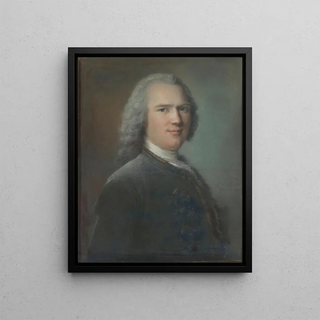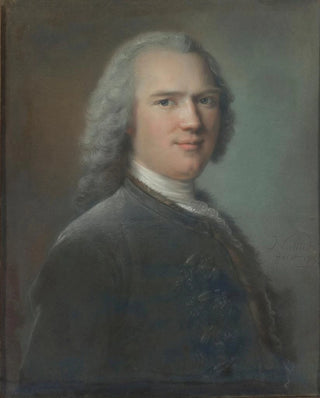Art print | Portrait of a gentleman - Jean-Marc Nattier Source: Reproduction | Portrait d'un gentleman - Jean-Marc Nattier


View from behind

Frame (optional)
In the vast panorama of 18th-century art, the "Portrait of a gentleman" by Jean-Marc Nattier stands out for its elegance and finesse. This artwork, emblematic of the rococo style, goes beyond merely depicting a man of high society; it captures the very essence of an era where refinement and sophistication reached their peak. Gazing at this art print, the viewer is immediately transported into a universe where light plays with shadows, revealing the subtleties of the subject's personality. Nattier, with his unparalleled talent, manages to transcend simple representation to offer a true immersion into the aristocratic world of the 18th century.
Style and uniqueness of the work
Nattier's style is characterized by meticulous attention to detail and a delicate color palette that evokes softness and lightness. In the "Portrait of a gentleman," every element, from the texture of the clothing to the expression on the face, is carefully crafted. The use of natural light, illuminating the gentleman's face while creating a subtle contrast with the background, demonstrates the artist's mastery of chiaroscuro. The pose of the subject, both relaxed and noble, suggests a complex personality, oscillating between confidence and modesty. This portrait does not merely freeze a moment; it tells a story, that of a man whose gaze seems to carry the weight of his experiences while revealing a certain serenity.
The artist and his influence
Jean-Marc Nattier, often regarded as one of the most refined portraitists of his time, successfully established himself on the French artistic scene thanks to his unique style and his ability to capture the soul of his subjects. Trained under the guidance of great masters, Nattier developed a personal approach that combines tradition and innovation. His influence extends beyond his era, inspiring many artists who followed in his footsteps. By incorporating elements of mythology and literature into his portraits, he not only enriched the genre of portraiture but also contributed to the evolution of French painting. The "Portrait of a gentleman" is a perfect example.

Matte finish

View from behind

Frame (optional)
In the vast panorama of 18th-century art, the "Portrait of a gentleman" by Jean-Marc Nattier stands out for its elegance and finesse. This artwork, emblematic of the rococo style, goes beyond merely depicting a man of high society; it captures the very essence of an era where refinement and sophistication reached their peak. Gazing at this art print, the viewer is immediately transported into a universe where light plays with shadows, revealing the subtleties of the subject's personality. Nattier, with his unparalleled talent, manages to transcend simple representation to offer a true immersion into the aristocratic world of the 18th century.
Style and uniqueness of the work
Nattier's style is characterized by meticulous attention to detail and a delicate color palette that evokes softness and lightness. In the "Portrait of a gentleman," every element, from the texture of the clothing to the expression on the face, is carefully crafted. The use of natural light, illuminating the gentleman's face while creating a subtle contrast with the background, demonstrates the artist's mastery of chiaroscuro. The pose of the subject, both relaxed and noble, suggests a complex personality, oscillating between confidence and modesty. This portrait does not merely freeze a moment; it tells a story, that of a man whose gaze seems to carry the weight of his experiences while revealing a certain serenity.
The artist and his influence
Jean-Marc Nattier, often regarded as one of the most refined portraitists of his time, successfully established himself on the French artistic scene thanks to his unique style and his ability to capture the soul of his subjects. Trained under the guidance of great masters, Nattier developed a personal approach that combines tradition and innovation. His influence extends beyond his era, inspiring many artists who followed in his footsteps. By incorporating elements of mythology and literature into his portraits, he not only enriched the genre of portraiture but also contributed to the evolution of French painting. The "Portrait of a gentleman" is a perfect example.






